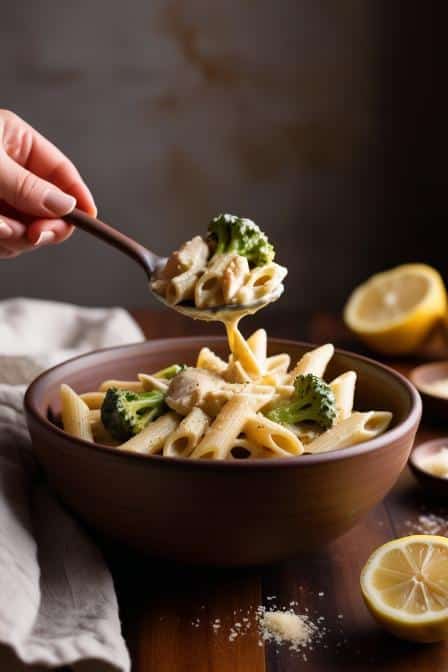Some dishes don’t just fill your stomach—they hug your soul. I still remember the first time I threw together chicken, broccoli, pasta, and cream on a rainy Tuesday night. I wasn’t expecting magic, but the steam that rose from that pot carried a smell so warm, so buttery, I swear I could hear my appetite applaud. This isn’t your average “pasta with stuff in it.” This is that silky, garlicky, comfort-loaded bowl that people finish and then look at you like you’ve just done witchcraft in the kitchen.
Creamy chicken broccoli pasta is one of those timeless dinners that walks the line between simple weeknight cooking and something you’d proudly serve to impress guests. It’s built on the comfort of al dente pasta, tender seared chicken, sweet green broccoli, and a sauce that’s not shy about its creaminess. What makes it special is how it balances richness with freshness—how that hint of green cuts through the cream like a whisper of spring on a winter day. And the best part? It’s endlessly tweakable for diet needs, spice levels, or whatever’s in the fridge.
Ingredients & Substitutions
The magic here is in the layering. Each ingredient is a building block—swap the wrong one, and the flavor leans differently. Sometimes better. Sometimes… not. The table below gives you the essentials for a hearty 4-serving portion, along with substitutions that won’t ruin the soul of the dish.
| Ingredient | Amount | Substitution | Notes |
|---|---|---|---|
| Boneless skinless chicken breast | 500g (about 1 lb) | Chicken thighs | Thighs give a richer, juicier bite |
| Broccoli florets | 300g (about 10 oz) | Broccolini, asparagus | Broccolini is sweeter, asparagus more earthy |
| Pasta (penne, fettuccine, or rotini) | 300g (10 oz) | Gluten-free pasta | Choose pasta that holds sauce well |
| Heavy cream (35% fat) | 250ml (1 cup) | Half-and-half, coconut cream | Coconut cream for dairy-free |
| Parmesan cheese, freshly grated | 80g (about ¾ cup) | Pecorino Romano | Pecorino is sharper, saltier |
| Garlic cloves, minced | 3 cloves | Garlic powder (1 tsp) | Fresh garlic gives depth you can’t fake |
| Olive oil | 2 tbsp | Unsalted butter | Butter gives a silkier, richer sauce |
| Salt | to taste | Sea salt, kosher salt | Use coarse salt for pasta water |
| Black pepper, freshly cracked | ½ tsp | White pepper | White pepper blends into the sauce visually |
| Chicken broth | 125ml (½ cup) | Vegetable broth | Adds savory depth |
| Lemon juice | 1 tbsp | White wine | Wine gives subtle acidity and aroma |
Fresh vs frozen broccoli? Fresh brings a snappier bite and brighter color. Frozen is softer, sweeter, and cheaper—but you’ll want to blanch it less so it doesn’t turn mushy. Pasta choice matters too. Penne hugs creamy sauces inside its tubes, fettuccine swirls in thick ribbons, while rotini’s spirals catch every fleck of cheese.
Step-by-Step Instructions
1. Prep the chicken. Pat your chicken dry with paper towels. This isn’t just fuss—moisture on the surface will steam the chicken instead of giving it that light golden crust. Slice into thin strips or bite-sized cubes. Season generously with salt and pepper. If you skimp here, the chicken will taste like… well, boiled paper.
2. Cook the pasta. Bring a large pot of salted water to a rolling boil. Drop in the pasta and cook until just shy of al dente—about 1 minute less than package instructions. Reserve a cup of that starchy water before draining. It’s liquid gold for adjusting sauce later.
3. Blanch the broccoli. In the last 2 minutes of the pasta cooking, toss the broccoli florets into the same pot. This saves you an extra dish and times the cooking perfectly so the broccoli stays vivid green. Drain with the pasta.
4. Sear the chicken. Heat olive oil in a large skillet over medium-high. Add the chicken in a single layer—don’t crowd the pan or it’ll stew. Sear 3–4 minutes per side until lightly browned and cooked through. Remove and set aside.
5. Build the sauce base. Lower heat to medium. In the same pan, add a touch more oil if needed, then the garlic. Sauté 30 seconds—just until fragrant, not burnt. Deglaze with chicken broth, scraping up all the flavorful bits stuck to the pan. That’s pure umami hiding there.
6. Make it creamy. Pour in the heavy cream and stir gently as it warms. Bring it to a lazy simmer, not a hard boil. High heat will split the cream faster than you can say “oops.”
7. Cheese it up. Stir in the grated Parmesan. Let it melt slowly into the sauce, thickening it into a velvety coat. Taste and adjust seasoning now—once the pasta’s in, the flavor’s locked.
8. Combine everything. Add the chicken back in, along with the drained pasta and broccoli. Toss gently until every piece is wearing a glossy cream-and-cheese jacket. If it feels too thick, splash in a little reserved pasta water.
9. Finish bright. Right before serving, stir in lemon juice. This tiny acid hit lifts the whole dish, cutting the heaviness without tasting lemony.
Common mistakes to avoid:
- Overcooking broccoli until it’s army green and floppy.
- Letting the cream boil (splits sauce).
- Adding cheese too early before cream heats evenly—it can clump.
Variations:
- For a spicy kick: add ½ tsp chili flakes with the garlic.
- For extra protein: swap half the pasta with chickpea pasta.
- For a mushroom twist: sauté 200g sliced mushrooms after the chicken.
Cooking Techniques & Science
This recipe works because of temperature control and starch management. Searing chicken first develops Maillard browning—those golden patches aren’t just pretty, they create deep savory notes. Cooking pasta just shy of al dente prevents overcooking during the final toss.
The cream and cheese combo works on emulsification—fat from the cream and oil binds with water from broth and pasta starch, forming a stable sauce. If the balance tips too much toward water, the sauce thins and won’t cling. Too much fat and it feels greasy.
Using starchy pasta water is more than tradition—it literally changes the sauce texture. Starch granules suspend in the liquid, thickening and helping sauce stick to pasta. Professional kitchens save it religiously.
Storage & Reheating
- Refrigerate: Cool fully, store in airtight container up to 3 days.
- Freeze: Not recommended—cream-based sauces can split after thawing.
- Reheat: Low heat on stove with a splash of milk or broth to revive the sauce. Avoid microwaving on high—it’ll dry the chicken and break the sauce.
Dietary variations:
- Vegan: Use plant-based cream, vegan cheese, vegetable broth, and seared tofu.
- Gluten-free: Swap in GF pasta and ensure broth is gluten-free.
- Dairy-free: Coconut cream + nutritional yeast for cheesy flavor.
Tools that make a difference:
- Heavy-bottom skillet: Distributes heat evenly, prevents scorching cream.
- Microplane grater: For ultra-fine Parmesan that melts instantly.
- Pasta spider or strainer basket: Makes transferring pasta and broccoli easier without losing the cooking water.
Serving & Pairing Suggestions
Serve in wide shallow bowls—pasta needs breathing room, not a soup bowl prison. Top with extra Parmesan and a grind of black pepper. If you want a restaurant-level look, drizzle with a touch of good olive oil and scatter a few microgreens or parsley leaves.
Pair with garlic bread for mopping up every last smear of sauce. A crisp side salad with lemon vinaigrette balances richness. For drinks, a chilled glass of Chardonnay or a dry sparkling water with lemon works beautifully.
Best Time to Serve
This pasta is at its prime the moment it’s tossed—sauce still glossy, broccoli still green, chicken still juicy. It’s the sort of dish that turns a weekday evening into a comfort feast, or a Sunday lunch into a low-key celebration. Cold winter nights or breezy spring evenings both suit it—richness for warmth, green for freshness.
Conclusion
Creamy chicken broccoli pasta is proof you don’t need a dozen exotic ingredients or a culinary degree to make something people will talk about for days. It’s all about treating each step like it matters—because it does. Drying the chicken, timing the broccoli, not rushing the sauce—these little acts separate a forgettable plate from a memorable one.
If there’s one tip to take away, it’s this: don’t just cook it, feel it. Taste as you go. Adjust like you’re steering a ship toward the flavor you want. The recipe is a guide, but your tongue is the captain.
FAQs
1. Can I make it ahead of time?
Not ideal. The pasta absorbs sauce as it sits, and the broccoli dulls. But you can prep chicken and broccoli earlier, then cook pasta and sauce fresh in under 20 minutes.
2. How do I stop the cream from curdling?
Keep heat moderate and avoid boiling after adding cream. Add cheese gradually once cream is warmed.
3. Can I add more vegetables?
Absolutely—peas, spinach, or zucchini fit right in. Just keep total veggie volume similar to avoid crowding the sauce.
4. Why does my sauce feel grainy?
Cheese added too soon or too hot can seize into clumps. Always melt it gently into warm cream.
5. What’s the best pasta shape for this dish?
Penne, rotini, or fettuccine—each holds creamy sauce well. Avoid very thin pasta like angel hair; it can’t support the weight of the sauce.
If you want, I can also create a professional chef’s “flavor layering” chart for this recipe showing exactly when each flavor component is introduced and why. It would make this guide even more expert-level. Would you like me to add that?

